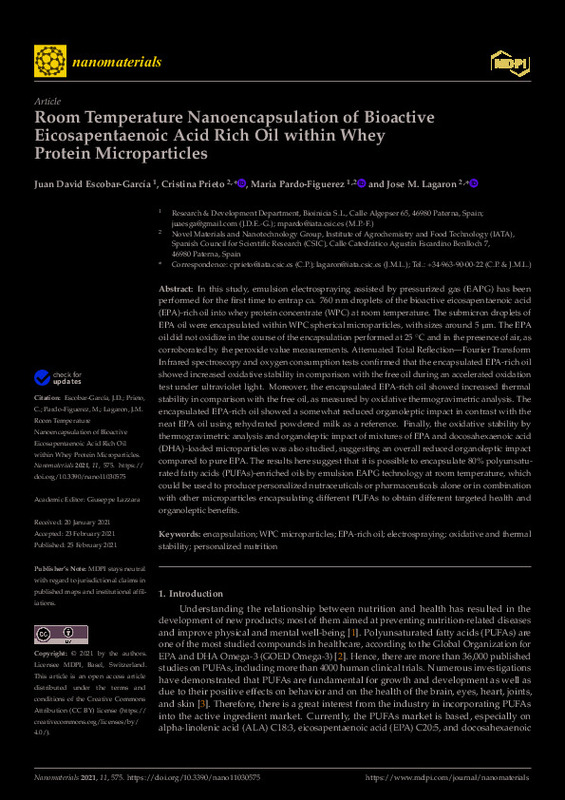JavaScript is disabled for your browser. Some features of this site may not work without it.
Buscar en RiuNet
Listar
Mi cuenta
Estadísticas
Ayuda RiuNet
Admin. UPV
Room Temperature Nanoencapsulation of Bioactive Eicosapentaenoic Acid Rich Oil within Whey Protein Microparticles
Mostrar el registro sencillo del ítem
Ficheros en el ítem
| dc.contributor.author | Escobar-García, Juan David
|
es_ES |
| dc.contributor.author | Prieto, Cristina
|
es_ES |
| dc.contributor.author | Pardo-Figuerez, Maria
|
es_ES |
| dc.contributor.author | Lagaron, José M.
|
es_ES |
| dc.date.accessioned | 2024-03-04T19:02:50Z | |
| dc.date.available | 2024-03-04T19:02:50Z | |
| dc.date.issued | 2021-03 | es_ES |
| dc.identifier.uri | http://hdl.handle.net/10251/202920 | |
| dc.description.abstract | [EN] In this study, emulsion electrospraying assisted by pressurized gas (EAPG) has been performed for the first time to entrap ca. 760 nm droplets of the bioactive eicosapentaenoic acid (EPA)-rich oil into whey protein concentrate (WPC) at room temperature. The submicron droplets of EPA oil were encapsulated within WPC spherical microparticles, with sizes around 5 µm. The EPA oil did not oxidize in the course of the encapsulation performed at 25 °C and in the presence of air, as corroborated by the peroxide value measurements. Attenuated Total Reflection-Fourier Transform Infrared spectroscopy and oxygen consumption tests confirmed that the encapsulated EPA-rich oil showed increased oxidative stability in comparison with the free oil during an accelerated oxidation test under ultraviolet light. Moreover, the encapsulated EPA-rich oil showed increased thermal stability in comparison with the free oil, as measured by oxidative thermogravimetric analysis. The encapsulated EPA-rich oil showed a somewhat reduced organoleptic impact in contrast with the neat EPA oil using rehydrated powdered milk as a reference. Finally, the oxidative stability by thermogravimetric analysis and organoleptic impact of mixtures of EPA and docosahexaenoic acid (DHA)-loaded microparticles was also studied, suggesting an overall reduced organoleptic impact compared to pure EPA. The results here suggest that it is possible to encapsulate 80% polyunsaturated fatty acids (PUFAs)-enriched oils by emulsion EAPG technology at room temperature, which could be used to produce personalized nutraceuticals or pharmaceuticals alone or in combination with other microparticles encapsulating different PUFAs to obtain different targeted health and organoleptic benefits. | es_ES |
| dc.description.sponsorship | This research was funded by the MICIU (RTI-2018-097249B-C1), EU H2020-MSCA-RISE2017-778388-FODIAC and the EU H2020-EIC-SMEinst-2018-2020-SME instrument-873827-CAPSULTEK, CDTI-CIEN DANTIAN-IDI-20190954 and the CYTED thematic network (319RT0576). J.D.E.-G. wants to thank the Spanish Ministry of Economy, Industry and Competitivity for his predoctoral grant (DI-6906). | es_ES |
| dc.language | Inglés | es_ES |
| dc.publisher | MDPI AG | es_ES |
| dc.relation.ispartof | Nanomaterials | es_ES |
| dc.rights | Reconocimiento (by) | es_ES |
| dc.subject | Encapsulation | es_ES |
| dc.subject | WPC microparticles | es_ES |
| dc.subject | EPA-rich oil | es_ES |
| dc.subject | Electrospraying | es_ES |
| dc.subject | Oxidative and thermal stability | es_ES |
| dc.subject | Personalized nutrition | es_ES |
| dc.title | Room Temperature Nanoencapsulation of Bioactive Eicosapentaenoic Acid Rich Oil within Whey Protein Microparticles | es_ES |
| dc.type | Artículo | es_ES |
| dc.identifier.doi | 10.3390/nano11030575 | es_ES |
| dc.relation.projectID | info:eu-repo/grantAgreement/EC/H2020/778388/EU | es_ES |
| dc.relation.projectID | info:eu-repo/grantAgreement/EC/H2020/873827/EU | es_ES |
| dc.relation.projectID | info:eu-repo/grantAgreement/CDTI//IDI-20190954/ | es_ES |
| dc.relation.projectID | info:eu-repo/grantAgreement/CYTED//319RT0576/ | es_ES |
| dc.relation.projectID | info:eu-repo/grantAgreement/MCIU//RTI-2018-097249B-C1/ | es_ES |
| dc.relation.projectID | info:eu-repo/grantAgreement/MINECO//DI-6906/ | es_ES |
| dc.rights.accessRights | Abierto | es_ES |
| dc.description.bibliographicCitation | Escobar-García, JD.; Prieto, C.; Pardo-Figuerez, M.; Lagaron, JM. (2021). Room Temperature Nanoencapsulation of Bioactive Eicosapentaenoic Acid Rich Oil within Whey Protein Microparticles. Nanomaterials. 11(3). https://doi.org/10.3390/nano11030575 | es_ES |
| dc.description.accrualMethod | S | es_ES |
| dc.relation.publisherversion | https:// doi.org/10.3390/nano11030575 | es_ES |
| dc.type.version | info:eu-repo/semantics/publishedVersion | es_ES |
| dc.description.volume | 11 | es_ES |
| dc.description.issue | 3 | es_ES |
| dc.identifier.eissn | 2079-4991 | es_ES |
| dc.identifier.pmid | 33668857 | es_ES |
| dc.identifier.pmcid | PMC7996356 | es_ES |
| dc.relation.pasarela | S\430139 | es_ES |
| dc.contributor.funder | European Commission | es_ES |
| dc.contributor.funder | CYTED Ciencia y Tecnología para el Desarrollo | es_ES |
| dc.contributor.funder | Centro para el Desarrollo Tecnológico Industrial | es_ES |
| dc.contributor.funder | Ministerio de Ciencia, Innovación y Universidades | es_ES |
| dc.contributor.funder | Ministerio de Economía, Industria y Competitividad | es_ES |








